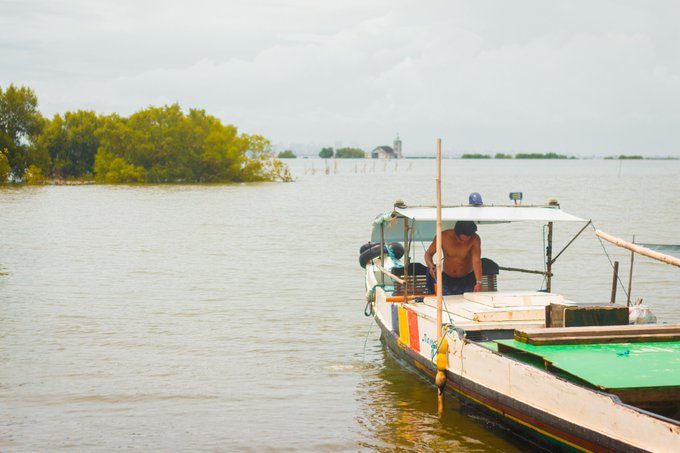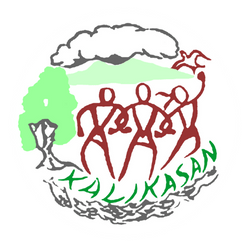Last 2018, I had the privilege of visiting Taliptip, Bulacan, before the construction of San Miguel Corporation’s New Manila International Airport (NMIA) reclamation project began. Many of the local fisherfolk we were able to visit lived fifteen minutes by boat away from the mainland, in small houses amid mangrove patches. Back then, fisherfolk were already worried about mangroves being cut down for the project.
All of that is gone now. In place of community, massive boats are now wreaking havoc over land and sea to build their airport city. The rich waters from which fisherfolk could catch all kinds of seafood have now been cordoned off from the general public. San Miguel Corporation (SMC) takes pride in its work, yet hundreds, if not thousands of families are suffering from loss of livelihood, residence, and culture.

Social and environmental impacts
The NMIA, also known as the Bulacan Aerotropolis, is unfortunately just one destructive project among many dotting the entire archipelago. The Philippine Reclamation Authority has documented 187 reclamation projects across the country. This number which even excludes projects like the Bulacan Aerotropolis, on the technicality that it is a “land development” project. With the scale of reclamation today, it is crystal clear that our government couldn’t care less about our fragile coastal ecosystems and the communities embedded in them.
What must be highlighted with these reclamation operations is that their impacts are far-reaching. Going back to the NMIA, the effects of the ongoing dredging operations extend well past its official 2,500-hectare coverage. Fisherfolk from Isla Pamarawan in Bulacan have been asking for compensation from SMC for the rising high tides they now have to contend with, which are likely a result of the displaced water from the construction of the airport. Communities in Navotas are now up against a separate reclamation project, a coastal expressway that will service the new airport. Dutch dredging company Boskalis draws sand from San Nicolas Shoal near Cavite for its operations related to the NMIA, impacting fisherfolk communities in Naic, Rosario, and other municipalities.
Despite all these, the proponents of these projects like to pretend that reclamation is environmentally sound. Rather than recognizing the possibility that reclamation can worsen local flooding, they claim that any and all reclamation helps address flooding issues. Where any local sea level rise occurs, they put the entire blame on global warming, instead of considering how reclamation can alter local hydrology. For every copse of mangroves cut down, all they do is plant a few seedlings in some other part of the country and send out a press release. All these things make it clear that many, if not all, of these companies are grossly unserious about responding to our ecological and climate crisis.
Reclamation and resistance
Many of these projects are holdovers from the previous administration. The Duterte administration was particularly enabling in this regard, with many of these projects popping up under its watch. Without a clear course of action, recent promises of investigation by the new Marcos Jr. administration mean little to the communities who bear the impacts. In many ways, the situation looks dire for the Filipino people.
It is in this context that resistance against reclamation projects continues, from grassroots communities to national-level networks. In recent months, fisherfolk groups in Bulacan, Navotas, and Cavite have been actively organizing anti-reclamation campaigns. Academic institutions have also been at the forefront of the struggle, providing much needed technical expertise that can cut through the half-truths peddled by reclamation proponents. Broad alliances like the People’s Network for the Integrity of Coastal Habitats and Ecosystems (People’s NICHE) have been clamoring for a dialogue with the new DENR Secretary Toni Yulo-Loyzaga in the hope that she responds to the call of the people for an immediate moratorium on these destructive projects.
The focus is now on the new administration to get its act together. We environmentalists are not against development. We are simply against development where only a few benefit, while the long-term interests of people and planet are disregarded once again. As long as these projects continue to bring us down a path of irreversible destruction, you can expect the Filipino people to keep organizing and fighting for a better and more sustainable present and future for all.
Jon Bonifacio (he/they) is the Acting National Coordinator of Kalikasan People’s Network for the Environment (Kalikasan PNE). He is also a member of the Advisory Council of international human rights watchdog Global Witness. A youth environmental activist, he previously served as the National Coordinator of Youth Advocates for Climate Action Philippines (YACAP).



![[OPINION] Reclaiming our future from reclamation](https://kalikasan.rappler.com/tachyon/sites/17/2022/10/Untitled-design.png)